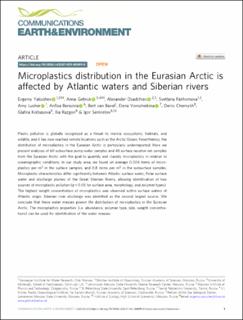Microplastics distribution in the Eurasian Arctic is affected by Atlantic waters and Siberian rivers
Yakushev, Evgeniy; Gebruk, Anna; Osadchiev, Alexander; Pakhomova, Svetlana; Lusher, Amy; Berezina, Anfisa; van Bavel, Bert; Vorozheikina, Elena; Chernykh, Denis; Kolbasova, Glafira; Razgon, Ilia; Semiletov, Igor
Peer reviewed, Journal article
Published version
Permanent lenke
https://hdl.handle.net/11250/2764641Utgivelsesdato
2021Metadata
Vis full innførselSamlinger
- Publikasjoner fra Cristin - NIVA [2149]
- Scientific publications [1172]
Sammendrag
Plastic pollution is globally recognised as a threat to marine ecosystems, habitats, and wildlife, and it has now reached remote locations such as the Arctic Ocean. Nevertheless, the distribution of microplastics in the Eurasian Arctic is particularly underreported. Here we present analyses of 60 subsurface pump water samples and 48 surface neuston net samples from the Eurasian Arctic with the goal to quantify and classify microplastics in relation to oceanographic conditions. In our study area, we found on average 0.004 items of microplastics per m3 in the surface samples, and 0.8 items per m3 in the subsurface samples. Microplastic characteristics differ significantly between Atlantic surface water, Polar surface water and discharge plumes of the Great Siberian Rivers, allowing identification of two sources of microplastic pollution (p < 0.05 for surface area, morphology, and polymer types). The highest weight concentration of microplastics was observed within surface waters of Atlantic origin. Siberian river discharge was identified as the second largest source. We conclude that these water masses govern the distribution of microplastics in the Eurasian Arctic. The microplastics properties (i.e. abundance, polymer type, size, weight concentrations) can be used for identification of the water masses.

